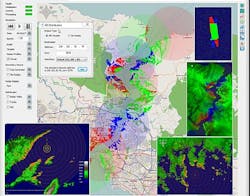Software tool for radar display test and validation introduced by Cambridge Pixel
CAMBRIDGE, England, 5 March 2013. Cambridge Pixel in Cambridge, England, is introducing the SPx Simulator software tool to help developers of complex primary radar display applications test and validate systems in advance of final integration.
SPx Simulator is for developers of military and commercial radar display applications including command and control systems, electronic chart display and information systems for commercial ships, and vessel traffic service systems for monitoring marine traffic.
The SPx Simulator software builds on Cambridge Pixel's SPx radar processing library to enable developers to build multi-radar simulations or scenarios, including terrain effects, primary radar targets, secondary targets (AIS, IFF, ADS-B) and navigation data.
The output of the simulator is a network stream of one or more primary videos in either SPx or Asterix formats, along with synchronized AIS tracks, primary tracks and NMEA 0183 navigation data.
It also can be used for tracker configuration, operator training or to demonstrate the possible radar clutter or expected radar coverage for a given location.
The SPx Simulator uses terrain elevation data from NASA's Shuttle Radar Topography Mission and includes tiled maps and world vector shoreline displays to add context to the radar video being displayed.
A Windows user-interface allows complex motions of targets and radar to be created, including effects of terrain on both the visibility of targets and the appearance of the primary radar. A radar display is built-in to the program to show the simulated radar video instantly.
SPx Simulator is part of Cambridge Pixel's SPx suite of software libraries and applications that provide software products for radar visualization, radar video distribution, plot extraction and target tracking.
For more information contact Cambridge Pixel online at www.cambridgepixel.com.

